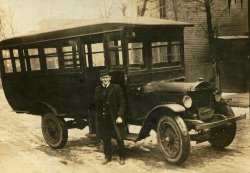
MAY CONTAIN NUTS

Search Shorpy
SHORPY ART

Framed or unframed, desk size to sofa size, printed by us in Arizona and Alabama since 2007. Explore now.
Join and Share
Ad-Free Shorpy
Shorpy is funded by you. Patreon contributors get an ad-free experience.
Learn more.

Recent comments
- Tough Guys
- Lost in Toyland
- And without gloves
- If I were a blindfolded time traveler
- Smoke Consumer Also Cooks
- Oh that stove!
- Possibly still there?
- What?!?
- $100 Reward
- Freeze Frame
- Texas Flyer wanted
- Just a Year Too Soon
- WWII -- Replacing men with women at the railroad crossing.
- Yes, Icing
- You kids drive me nuts!
- NOT An Easy Job
- I wonder
- Just add window boxes
- Icing Platform?
- Indiana Harbor Belt abides
- Freezing haze
- Corrections (for those who care)
- C&NW at Nelson
- Fallen Flags
- A dangerous job made worse
- Water Stop
- Passenger trains have right of way over freights?
- Coal
- Never ceases to amaze me.
- Still chuggin' (in model form)
Member Photos
The Shorpy
Print Emporium
Print Emporium
Search Shorpy
Search results -- 30 results per page
- Hung Out to Dry: 1939
- April 1939. "Jersey City and Manhattan skyline." 35mm nitrate negative by Arthur Rothstein ... with that view of the skyline (when the day was clear), Jersey City would have been a bunch of Manhattan strivers. But it was mainly ... to the Erie Railroad, whose eastern terminal was there in Jersey City. NJ-NYC commuters, like my father, would take the ferry across the ... Posted by Dave - 09/13/2011 - 10:50pm -
![Hung Out to Dry: 1939 April 1939. "Jersey City and Manhattan skyline." 35mm nitrate negative by Arthur Rothstein for the Farm Security Administration. View full size.
You may find yourself living in a railroad flat... right next to the Erie Lackawanna tracks. Those trains cars were still in service until the 1980s, and durable old warhorses they were.
What is most striking - and horrifying - to me is the amount of particulates and soot in the air. I sometimes forget how densely covered with coal soot, diesel exhaust and oil-furnace smog cities would be on an overcast or air-inversion day. It sure didn't help the tubercular. Tuberculosis was still a scourge, and would be until the invention of Streptomycin 5 years later (also in New Jersey, at Rutgers.)
You'd think that with that view of the skyline (when the day was clear), Jersey City would have been a bunch of Manhattan strivers. But it was mainly port guys, Irish longshoreman who would defend their territory with fists and bats. It was as gritty as it looks.
Any Bets?It is a good chance this picture was taken on a Monday. Back in the day that was the day to do the washing, mending, and ironing.
White SalePeople certainly wore a lot of white clothes.
Erie RailroadAs mentioned previously the passenger cars, which were dark brown like the old U.S. Mail boxes and mail trucks, belonged to the Erie Railroad, whose eastern terminal was there in Jersey City. NJ-NYC commuters, like my father, would take the ferry across the Hudson River, weather permitting, and the "Hudson Tubes" subway (now PATH) under the river when the weather was bad. In 1960, the Erie Railroad merged with the Lackawanna Railroad to form the Erie Lackawanna Railroad, at which time they switched their terminal to the Lackawanna facility in nearby Hoboken. One of the most interesting characters in U.S. political history was Frank "I am the law" Hague, who reigned supreme as Jersey City Mayor from 1907 to 1947.
Poor QualityThe shots of '39 Jersey City are interesting in that it appears Arthur Rothstein was 1) using an inferior camera; 2) an inferior lens on a good camera; 3)poor quality film; 4) poor quality development. Be interesting to know which.
There are other photographs by Rothstein using a 35mm camera that are quite up to standard; and his medium and 4x5 works are masterpieces.
[His 35mm camera was a Leica. - Dave]
Jersey SootyWith all that smoke in the air, I'll bet their clothes were gray by day's end. Makes you wonder what the difference was between air quality then and now.
Clothesline pulleysI'll bet if you went to the back windows of those tenements today, you'd still find the pulleys attached to the windows. You can still find the poles in the back yards, and the pulleys on the windows in Brooklyn. All they need are new ropes. A very earth friendly way to dry your clothes!
That's where the well-to-do now liveIn this era, that part of Jersey City is making a comeback as the heir-apparent to well-to-do apartment living. Many of the old factories have been converted to condos, including the former Hague-built Jersey City Medical Center (too far to the west to be in this photo). Most of the buildings in the foreground - the ones that survive - have been converted to apartments, much in the manner of the better areas of Brooklyn that were of the same vintage. Part of the distant area in the photo is now know as Newport Center, and several of the old blocky warehouses are now tony condos for commuters via the nearby PATH into Manhattan. No where near as sooty as it was even in my childhood in the 1950's. I'm trying to find out what that greek-columned building was/is - it looks familiar to me, but I am not sure of the exact location and haven't had any luck finding it on Google - I think it's on Marin Drive or Grove Street, north of the Holland tunnel, just on the JC side before Hoboken. I'll just have to keep looking.
"The muggers are mugging the muggers"Jersey City has always been a dense, gritty city with its share of slums. However, it was a pretty safe city until the 1960s, when things started to deteriorate. My grandfather, who lived in the Greenville section, used to say "Jersey City is getting so bad, the muggers are mugging the muggers." He wasn't far off. While it's a little safer today, there are still many parts of the city where you don't want to be walking at night. And the majority of the buildings date from the late 19th and early 20th century. Fortunately, the misguided highrise public housing projects are coming down (Currie's Woods, Montgomery Gardens), and the JC waterfront is being built up to the point where its skyline has overtaken Newark's as the best in the state. The spillover from Manhattan that started in the '80s to escape the high cost & taxes continues today.
Jersey CityThe intersection at the far left right above the trains is Jersey Avenue & 10th Street. The park is Hamilton Park. The building with the columns is not there any longer. Nor is the building with the kind of cupola adjacent to the park. But you can make out Harborside Financial Center in the distance, that was the key. Most the other industrial buildings in the distance are gone. Photo probably taken from the roof of the Erie warehouse bounded by Coles, 11th, Monmouth, and 12th.
(The Gallery, Arthur Rothstein, NYC, Railroads)](https://www.shorpy.com/files/images/8a10973a.thumbnail.jpg)
- Jersey City: 1939
- April 1939. "Jersey City, New Jersey." A trackside tableau. 35mm nitrate negative by Arthur ... a little pavement and this could be the 1800s. Of course, Jersey City is still just as attractive today.
Ties that bind Lots of ... Posted by Dave - 09/16/2010 - 7:36am -
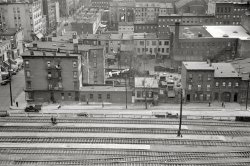
- Jersey City Newsies: 1912
- ... "3 p.m. Some of the boys at a busy trolley junction in Jersey City. Three brothers, Salvatore, 9 yrs. (in front), Joseph, 11 yrs. ... Posted by Dave - 09/07/2011 - 3:00pm -
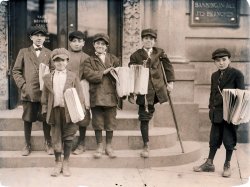
- Jersey City Home: c. 1940s
- ... is a 1940s photo of a 19th century three-family home in Jersey City, NJ, that my grandmother lived in. I'm unsure of the street it was ... Posted by Photoscream - 07/27/2010 - 11:05am -
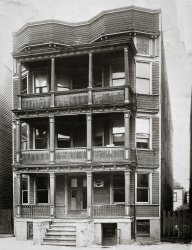
- Ellis Island: 1911
- ... from the Black Tom explosion of 1916.
A website for Jersey City history notes that: "the Statue of Liberty sustained $100,000 in ... Posted by Dave - 08/01/2012 - 5:43pm -
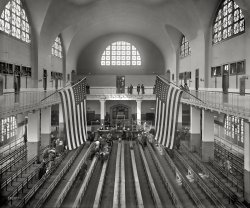
- Plane No. 7: 1900
- ... served Boonton's iron industry between Phillipsburg and Jersey City. Iron crossed over the Jersey Hills by use of 23 lift locks and 23 ... Posted by Dave - 12/15/2022 - 12:28am -
![Plane No. 7: 1900 Boonton, New Jersey, circa 1900. "Top of plane, Morris and Essex Canal." 8x10 inch dry plate glass negative, Detroit Photographic Company. View full size.
Read if so inclinedI didn't know this, so maybe others don't too:
A [canal] inclined plane is a type of cable railway used on some canals for raising boats between different water levels. Boats may be conveyed afloat, in caissons, or may be carried in cradles or slings.
This would be the long way roundAt least it would be today. Between 1824 and 1924 the Morris Canal served Boonton's iron industry between Phillipsburg and Jersey City. Iron crossed over the Jersey Hills by use of 23 lift locks and 23 inclined planes. Thank you, Kiwanis.
Painting of the Boonton LockI am so very happy to see this image Shorpy-fied!
My grandparents lived two blocks from the Boonton lock and plane. He, F. C. Wells, was a Manhattan architect and painter. In the 1940s (or maybe '50s) he created a rather surreal image of the "guard lock" at Boonton (attached). I don't know for certain, but I think he painted this collage of imagery over another painting -- as suggested by the church turrets in the background and the forested mountain on the right.
D&H CanalVery cool. I remember my father mentioning it a few times, he was born in 1917 in Irvington. Up here in Ulster County there are a couple of museums celebrating the Delaware and Hudson Canal, roughly the same time period, running from Pennsylvania coalfields to the Hudson River. Coal then moved on barges down the Hudson. It was built in ten years. There's an inland town along it’s its length called Summitville because it was the highest point on the canal. This being a more rural area, there are lots of parts remaining.
+120 YearsThe building on the left with the bay windows is still standing:
The inclined plane started by the intersection of Main Street and School Road. You can see where the canal and inclined plane were on this old map of Boonton.
Lots of great then-and-now photos (including another view of the top of the plane) at Boonton.org.
(The Gallery, Boats & Bridges, DPC, Railroads)](https://www.shorpy.com/files/images/SHORPY-4a07225a.thumbnail.jpg)
- The Heart of New York: 1907
- ... Railroad, which ran from that region of Pennsylvania to Jersey City. I must presume that the goods that were to be transshipped from ... Posted by Dave - 08/21/2012 - 12:38pm -
![The Heart of New York: 1907 Circa 1907. "The heart of New York (Manhattan skyline from Brooklyn)." The Singer Building rises. 8x10 glass negative, Detroit Publishing Co. View full size.
Ghost TownNot a soul in sight!
[They are there, just really tiny. - Dave]
Even TodayThe best views of Manhattan are from Brooklyn, Queens and New Jersey.
Singer TowerThe Singer (sewing machine company) tower, under construction was the tallest building in the world for a couple of years. It was demolished at a youthful 60-years old.
Tall ShipsIt is interesting to see ships with masts and sails plying the waters around Manhattan. There is a large three masted ship tied up to the pier, slightly left of center. I can remember going to The South Street Seaport Museum to look at the Peking and the Wavertree.
Indecently, the South Street Seaport Museum is located at Pier 16 On the East River. Pier 16 is the right hand pier of the two Mallory Line Piers.
Transportation History DivinedI just realized how the waterfront railroad terminals in New Jersey worked!
If you look closely, several of the barges are from the Lehigh Valley Railroad, which ran from that region of Pennsylvania to Jersey City. I must presume that the goods that were to be transshipped from freight cars to ships or the city itself were loaded on to barges and then delivered to the deep water piers in Brooklyn and Manhattan for delivery in the city or loading on to ocean going vessels. Thus explaining why all the great photographs I've seen on Shorpy feature so many small barges, lighters, and other riverine craft.
I imagine the completion of the New York Central Railroad's High Line was a serious blow to the LVRR and other lines on the New Jersey side of the Hudson and the Holland Tunnel doubly so. Imagine what New York City would be like if there had been a more efficient rail system from New Jersey to the docklands of the East River.
How did it take me so long to figure this out?!
What's going on here?Heavy traffic out there! Up until the 1960s-1970s, various railroads transferred huge amounts of cargo to and from the city by barges called carfloats carrying rail cars. Several railroads had small switching yards isolated from their main lines fed by carfloats, plus warehouses as well. Those railroads also often had their own “navies” of tugs and barges to transfer cargo to and from ships in the harbor..
Note the covered barges (AKA house barges) in the foreground marked for the Lehigh Valley RR. The one at far right is owned by the Lackawanna RR. The covering structure allowed secure storage and protected cargo from the weather during transfer. Covered barges had side doors to allow direct transfer to freighters that also had side doors. The freighter in foreground right looks to be transferring cargo via one of the barge’s roof hatches located over its side door.
At far left are 2 hold barges, apparently one with coal being loaded onto the ship alongside. Those barges were mostly owned by coal companies.
A stick lighter (AKA gas hoister) is at bottom right with others elsewhere in the picture. Essentially a derrick on a barge, they were used to handle heavy/bulky items. The bigger one opposite is a self-propelled steam lighter. Those were used for making faster transfers of goods – no waiting for tug service.
A good reference is “New York Harbor Railroads in Color, Volume 1” by Thomas R. Flagg (Morning Sun Books, 2000)
(The Gallery, Boats & Bridges, DPC, NYC)](https://www.shorpy.com/files/images/4a22396a.thumbnail.jpg)
- Scranton: 1900
- ... who grew up (after she got off of the boat) near the Jersey City terminus of the Delaware Lackawanna from about 1904 until 1922.
... Posted by Dave - 08/05/2012 - 6:27pm -
![Scranton: 1900 Scranton, Pennsylvania, circa 1900. "Delaware, Lackawanna, and Western Railroad yards." Judging by the fellow in the white coveralls, I'd say this plate was exposed not long after this one. Detroit Publishing Co. View full size.
Rock Island boxcarTwo tracks behind locomotive 808 is a Rock Island boxcar. On the left side of the boxcar are the words "Chicago, Rock Island and" (with "Pacific" being obscured.) The right side of the boxcar shows the earliest primitive Rock Island Route "beaver skin" logo. If this image was taken in 1900, then this would predate the oldest known image of the logo by two years. Unfortunately, the boxcar is missing from the stitched version.
Scranton D, L & W RR yardsThe two images Scranton: 1900 and Old King Coal: 1900 put together, using some cut & paste techniques. The difference is only one freight train, the smart observer Dave recognized the man in the white overalls, who seems to have solved the "bilocation" problem! View full size.
DL&W, et alWonderful of the Scranton DL&W yards, but this was not the only rail operator. Vestiges of track can be found all around Scranton and the adjoining towns. The major players included the St. Lawrence & Hudson, Deleware & Hudson, NY-Ontario & Western, Jersey Central, Erie, Reading & Northern, and of course, DL&W. It is said that some 35 freight lines operated through Scranton at one time or another. In addition, the area was served by light rail, interurban, and trolley companies. The buildings just visable at right in the photo are, of course, long gone and replaced by a shopping mall.
MDTCIn the middle-ground about five or so tracks from the left edge of the photo (just to the right of the gas lamp in the foreground), is a Merchants Despatch Transportation Co. freight car, such as seen in this recent Shorpy image:
https://www.shorpy.com/node/8252
It's the only MDTC car "representing" in the Scranton image, and the serial number doesn't match, but it's still a pretty cool coincidence.
GraffitiAre those large signatures chalked on the boxcars? Interesting to see the predecessor to today's "art crimes."
Grimyis the word that describes this photo.
re: GraffitiThese chalk marks aren't the same as modern graffiti. Conductors would mark the cars and yardmen would use the marks to help breakup and classify the cars when they were in a yard.
Pretty hellish if you ask meOf course, no one asked me. But jeez, what a hellish scene. Lung-blackening coal dust, soot, poisonous coal fires, smog from all the steam, steel shavings and dust from screeching wheels on tracks. I'm surprised you didn't drop dead after an hour here.
I love the old railroads anyway.
Total Depth of FieldIt would be interesting to know the details on how this photo is in focus from just a few feet from the light fixture to infinity. Is this a Shorpy/Dave technique or as is?
[It's a standard view-camera view. - Dave]
Gritty CityBeing a postwar baby and raised in Scranton, I too felt that carryover grime. And it somewhat extends to this day!
A Slippery Slope.Both photos are taken from an elevated coaling trestle. Coal in bottom-dump gondola cars was pushed by a locomotive up the inclined trestle towards the camera onto a dead-end portion of level track (behind camera) which had sloped-bottom storage bins beneath.
The coal was then dumped thru holes in the trestle deck into the bins below.
Locomotives to be coaled were run along side the coal trestle at ground level, and then an upward-sliding door at the bottom of the coal bin was opened by the man taking coal, which allowed coal to flow down a chute and into the coal bunker in the tender of the locomotive being fueled.
Sand for locomotive traction was usually put into the sand domes of locomotives at or near the coal chutes using the same manpower for both tasks.
Sand was kept nearby and dried in the sand house around a coal-fired heater, then moved up to its bins above the service tracks and supplied by gravity to the sand domes on locomotives. On oil-fired locomotives sand would be put into a separate bunker behind the cab to be poured into a hole in the firebox door while the engine was working hard to remove the oil soot from the firebox walls, the firetubes and the superheater elements to improve heat transfer to water in the boiler.
Road locomotives were usually coaled and sanded on their arrival from a run before going to the roundhouse.
If the rails were wet, the engineer pushing cars of coal would have to take a run at the hill, yet, be ready to stop as soon as the cars reached the level track atop the coal chute, or they would go off the end.
The broken blocks of wood visible on the walkway to the left of the track would be used by switchmen to block the wheels of cars on the slope.
There is no walkway on the opposite side, as the engineer was on the right of the locomotive and would be pushing the cars on the front of the engine to keep the water in the boiler at the rear over the firebox.
If the roundhouse dispatched, say, 20 road locomotives a day, each requiring 10 tons of coal, would mean at least 200 tons of coal would have to be moved up the coal chute ramp (and the empties brought back down).
Using 40-ton cars would mean at least five cars a day up the slope.
The small yard locomotives would also take coal from time to time, but, as they were usually never out of sight of the coal chute, it was not as important to have a full tender when going to work on their shift.
The steepness of the grade might limit the yard engine to only two or three cars a trip up, as care had to be taken.
The sand would come in boxcars to keep it dry.
One major problem of the camelback locomotives shown to the right was that if one of their side rods or the main rod broke while in motion, the loose end still attached to the crank pin on a driving wheel would flail around, and wipe the cab and the engineer off the side of the locomotive.
If the engineer was incapacitated, or worse, and the throttle not shut, you could then have a runaway.
The "graffiti" on the sides of the boxcars is probably car destinations chalked on by yardmen at originating terminals.
In 1900, not all freight cars would have air brakes, and, generally, they would be handled at the rear of freight trains, the air brake cars and their air hoses coupled directly behind the locomotive.
Comparing the two photos, two switchmen can be seen riding the tops of boxcars to the right beyond the locomotives, they in position to relay hand signals to the engineer on their own locomotive in the distance when a coupling is being made onto other stationary cars.
At night lanterns would be used and an engineer would have to be sure he was watching the right lamp in a busy yard.
Switch stands would have oil lamps displaying standard colours to indicate their direction at night, and a wood or metal "target" by day.
In 1900, steam was still the lifeblood of industry and many plumes of steam can be seen both on and off the railway.
Another great photo!
Tain't GraffitiBack in those days, yard crews would scribble instructions on the car. Things like where it was going, fragile load, destination, repairs needed, etc. Makes switching a whole lot easier.
Where do you worka John?Where do you worka John?
On the Delaware Lackawan
What do you do-ah John?
I poosh I poosh I poosh.
Whata do you poosha John on the Delaware Lackawan?
On the Delaware Lackawan I poosh I poosh the broom
-- Song sung by my Italian grandmother, who grew up (after she got off of the boat) near the Jersey City terminus of the Delaware Lackawanna from about 1904 until 1922.
Contents and destinationSeveral men of my father's family worked these yards in Scranton. I remember him saying the yardmen would mark this information on the cars to aid in switching. He never said what happened when it rained!
Stub end tracksWhat's amazing is the stub end tracks without bumpers or wheel stops on the ends, must of been interesting to park cars on these tracks if you didn't have a brakeman spotting the cars. The box car on the left # 33551 as I can make out, looks like it ran off the end. Also notice the really neat camelback locos on the right. The engineer rode in the cab right next to the boiler (must have been real hot in the summer) while the fireman rode on the rear, stoking the fire, which wasn't much of a comfortable ride either, especially on rough track. Great photo and so clear after 110 yrs.
DL&WWe tend to get all nostalgic when we think of railroad travel "back in the day," but it wasn't always perfect efficiency. When my grandmother used to ride the DLW a hundred years ago, they used to joke that the letters stood for Delay, Linger and Wait.
Industrial steeplesNot mentioned yet is the forest of church steeples across the skyline. As with many industrial towns, Scranton's population had many countries represented and each ethnicity usually had its own church. My wife's from Scranton, and I remember parking in the lot of a (perhaps) German parish to go to Christmas Mass in the Slovak parish church on the same block. Or maybe it was an Italian parish.
A bit of that Hades-like scene remains today in Scranton as the Steamtown National Historic Site railroad museum, a National Park Service attraction.
Same Location Scranton DL&W Rail Yards nowMy picture taken from approx. the same location. The old DL&W rail yards are now Steamtown National Historic Site.
re: Where do you worka John?In the version I heard, "I poosh, I poosh, I poosh" was followed by 'Poosha, poosha, poosha, poosha, -poosha, poosha, poosha."
I was a railroad freight handler in 1955 and I actually heard an Italian freight handler say "poosha" in connection with moving some freight.
(The Gallery, DPC, Railroads, Scranton)](https://www.shorpy.com/files/images/4a18925a.thumbnail.jpg)
- Brooklyn Wading Pool: 1942
- ... drive through it--as I do daily in places like Trenton, Jersey City, Newark, and Paterson NJ--you might think differently, should you ... Posted by Ken - 09/08/2011 - 6:48pm -
![Brooklyn Wading Pool: 1942 Children play in a wading pool at a play center at the Red Hook housing development, Brooklyn, New York. The charge to use the pool is nine cents for children, 25 cents for adults. Photograpy by Arthur Rothstein, June, 1942. View full size.
Wonder what it looks like today...Instead of water, that pool is likely filled today with empty crack vials and shell casings.
Actually...I assume this pool was in Red Hook Park, but It's not there at all now.
I ride my bicycle through this area all the time and haven't lost a tire to empty crack vials or shell casings.
Or maybeit has to do with that the original poster believed it to now be a high crime high drug use area.(shakes head as well)
It looks like trees and some kind of play areaA satellite view of the area shows some dark square areas surrounded by trees, possibly basketball courts? The apartment blocks are still there, southwest of the park but still on the same block.
I suppose the "crack vials and shell casings" comment has to do with the fact that the neighbourhood, which was once white, is now mainly black. (shakes head)
better satellite viewCharlene, the satellite view you used is off by a few blocks. The pool is still there but a few blocks east.
the mixed blessing of public housing projectsIn 1942, when this picture was taken, we as a society, still thought that we could solve poverty by creating consolidated housing projects like the one shown. At their best, resources like this pool were available to kids who might otherwise be swimming in the polluted waters of New York Harbor. But sadly, in the 65 years since, we have discovered that this sort of project actually tends to foster more crime, and can create more abject forms of poverty than the tenaments they replaced. Hence an earlier poster's "crack vials and shell casings", which doesn't necessarily have anything to do with the color of the people living there. I think Red Hook is pretty racially mixed right now.
PoolI was born in Red Hook in 1944 and lived there for several years. My aunt lived until sometime in the 70s or 80s. I recognize the look of the building in the background, but neither I nor my older brother remember the wading pool. What street was it on? We lived on Henry Street. We also remember a regular pool very close (I think on it was on Lorraine Street). There was also a park with a pool with sprinklers.
Anyone remember the Clinton Movie theatre?
Go Ahead...Shake your heads all you want, and keep telling yourselves that the inner city of today is a wonderful place to be. Should you actually drive through it--as I do daily in places like Trenton, Jersey City, Newark, and Paterson NJ--you might think differently, should you choose to take your blinkers off, that is. The locals, I'm sure, would love to make your acquaintance.
Possibly dumb questionFor those of us who've not lived in an area where such things are common---what exactly is the difference between a tenement and a housing project, and is a tenement just the same as a cheap, seedy apartment? Why should one be more prone to foster crime than another?
Red Hook TodayThe wading pool is gone. There is no mention of it in the NYC Parks Department web site. The Red Hook swimming pool is still a going concern. It is not filled with broken glass, litter, crack vials, or shell casings. Lost World, I don't know where you're from, but I can tell you that Red Hook today bears almost no resemblance to the red Hook of 20, or even 10 years ago. The projects are still there, and yes, they still suck. The rest of the neighborhood is fast becoming quite the desirable residential neighborhood.
Red Hook PoolCan't help you with any information about the wading pool. The Red Hook Swimming Pool is still going and is on Lorraine Street.
Filled with waterThe Red Hook pool that is under discussion here (not the wading pool shown above) today is not filled with some of the things that were asserted below. Rather, it is filled with water. Clean water. And people. A diverse group of families, to be specific.
Say What?Apparently no one has been to Red Hook lately, which boasts both an Ikea and the upscale Fairway Market. Inner city neighborhoods in New York City have become gentrified, you'd have less trouble buying an excellent key lime pie in Red Hook then getting either crack or ammunition.
Wading poolThat wading pool was in the park on Clinton Street across from the much larger Red Hook Pool. When I lived there as a young boy in the 80's it was still there minus the water. I used to ride my bike in that space. It's now filled in and part of quickly disappearing history of Red Hook.
Hooverville in Red HookWe are two norwegian authors writing a book about the big Hooverville in Columbia Street, in the area where the park is, beside the big grain elevator. if someone knows some old people who lived in Brooklyn in the 1930s, please send e-mail me! Kvarog@hotmail.com
This Wadding Pool LocationIt is no longer a wadding pool. It was filled in then made into a track. You can see it right across the street from the Red Hook Pool today. I have lived in THE HOOK for 37 years and i remember playing in it and remember it used to be open in the late 70's early 80's.
[Red Hook Pool -- full of wadder, I'll bet. - Dave]
Clinton Street movie theaterI was born in 1943 and lived in the Red Hook housing projects until 1954 when we escaped to suburbia. I have wonderfully fond memories of those days at the pools, at the stadium, at the docks and definitely at the Clinton Street movie theater. I went to P.S. 30.
The Clinton Theater played two features, five cartoons and a serial (Flash Gordon, Tim Tyler's Luck) each Saturday from 11 to about 4.
I learned to ride a bike at Coffey Park, was mugged there, skated and went to see the Yo-yo man each summer when a new yo-yo was introduced.
I'm writing a YA book detailing the life and times of three young boys who live in the housing project during the time of my youth (about 1953). Hope to finish it this winter and publish it as a Kindle book.
It's still there.....I'm sure the wading pool was there because of the picture. Just as well as the movie theatre.
However, it looks like it is the home to a reconstructed track and 4 new basketball courts for all the ball players and future Carmelo Anthony's of RED HOOK. It's also the home to the classic ball games that many come to from all around to watch. It also has a nice sized playground for the children that caters to the ever growing diversified population of people making new memories. Crack doesn't even exist in RED HOOK anymore. If it does you do not see it. I know I don't.
And RED HOOK POOL... it's still there! If RED HOOK is such a bad place to live in and it is so full of drugs and corruption and all the negativity that people are quick to judge and whom obviously doesn't have a clue because they are not from there, then why the sudden urge to move in?
(Arthur Rothstein, Kids, NYC)](https://www.shorpy.com/files/images/8e05132u.thumbnail.jpg)
- Singer Building: 1913
- ...
Old and New For a kid who grew up in Manhattan and Jersey City, the Singer was interesting in a grotesque kind of way, like a ... Posted by Dave - 08/01/2012 - 5:43pm -
![Singer Building: 1913 New York circa 1913. "The Singer Building." Rising in the distance, the Woolworth Building under construction. Detroit Publishing Company. View full size.
Pie in the sky, my eyeToday the building would be converted to condos or apartments (or a hotel, like the PSFS in Philadelphia) and would be a huge success. Nobody thought of that in 1967, because ... because they didn't want to think of anything except demolition.
Here's the piece of sky-pastry that the Singer Building was swapped for:
Old and NewFor a kid who grew up in Manhattan and Jersey City, the Singer was interesting in a grotesque kind of way, like a giant rotten tooth. Aesthetically and functionally the U.S. Steel building (which will probably long outlive the Singer) was a big improvement. Still, something was lost -- it would be nice if the Singer was still there. But that's the way it goes.
Quo Vadis SingerThat is just a gorgeous building. Looks like something out of "The Fountainhead." Why on earth did they let that one disappear?
Yikes.I guess this would be the classic example of "it looked good on paper."
The more things changedThe Singer Building was the first big test for New York's Landmarks Preservation Commission, which was formed after the outcry over demolition of Pennsylvania Station. The Commission failed miserably, allowing the destruction of the Singer Building in 1967 on the grounds that there was nothing else to do with it. It is the largest structure ever demolished for "peaceful" (i.e. money) reasons.
A real shameDoing a little research, you can see that the newly formed NYC Landmarks Commission really failed its mission in letting this building be torn down. There is nothing else like it in NY. If you do a little net research, you can find some detailed exterior and interior pix. I wish I could have seen what those spaces are like up in the crown. It must have been spectacular.
Impressively somethingTop kind of scary!
Pie in the Sky NotionsI wonder what some of the commenters here are thinking -- if you are the owner or shareholder in a piece of property, the government can tell you what to do with it (including taking a loss on it) just because people think it looks cool?
There's a limit to what tenants are willing to pay per square foot in any given building -- if there's a more attractive deal elsewhere, they'll take it. And what they were willing to pay in the Singer Building was, by the mid-1960s, less than what it cost to keep the place going. So they began to bail out, starting with the Singer Company itself.
The Landmarks Preservation Law is on shaky ground when it comes to giant office buildings -- something the preservation commission recognized when it declined to give the building Landmark status. It's private property, and the owners need to make a profit -- they'll abandon their investment or sue if the government makes a move toward de facto expropriation.
Alan Burnham, executive director of the Landmarks Preservation Commission, in 1967: "If the building were made a landmark, we would have to find a buyer for it or the city would have to acquire it. The city is not that wealthy and the commission doesn't have a big enough staff to be a real-estate broker for a skyscraper."
Talk is cheapThe reason the owners "thought of demolition" was they wanted to put up a big new office building that tenants would actually want to rent, and make a lot of money. Which they have every right to do. They ended up a with a building that paid a lot more in property taxes than the Singer ever did.
It's one thing to say the building should have been preserved, but, as pointed out below, the city (meaning you, the taxpayer) would have had to compensate the owners for their lost income. The money wasn't there, for understandable reasons.
One of the all-time greatsIt's a darn shame the Singer Building was demolished. It once held the title, very briefly though, as the tallest building in the world. GlenJay's right, had any decent creative thought been given to renovating the building for lucrative use, it would still be there today instead of the eye sore called 1 Liberty Plaza.
12 Fifth AvenueI always figured that the design of the Singer Building had much in common with that of the old apartment building at 12 Fifth Avenue, on a much larger scale, of course. 12 Fifth still stands between 8th and 8th Streets on the west side of 5th. Wish I had a photo of it. I lived there for two years between 1964 and 1966. Those were the Good Old Days.
Shame to lose it, but --It's a terrible aesthetic loss but the sad fact is that a building this old generally has severe handicaps for use today. Simply rewiring it for modern power (not to mention adding modern phone and computer lines) is a tremendous expense- everything is buried under plaster and masonry. These old buildings were firetraps- vast improvements over their predecessors but still dependent on someone finding a hose or fire extinguisher not all of these buildings had sprinklers. Most of these buildings depended on an open window for cooling in the summer- to refit a structure like this for modern use you've often got to strip the interior to the skeleton. Even if you could do everything needed you're up against the reality of life in NYC- the occupancy of the building might be too small to bring in enougfh money to cover costs and taxes. It's a sad thing.
Flag RaiserI'd hate to be the guy that had to go up there to raise the Singer flag.
You can't afford it.Even by 1967 standards, which are much much looser than today's standards, the building is not a viable commercial property. Look at how SMALL the floors of the tower are - now subtract space for ( 4 ) modern elevators, ( 2 ) fireproof stairways as far apart as possible, restrooms, an exit access corridor, plus space for structural columns, ventilation, air conditioning and heating equipment, and what you have left is somewhat less than half of the floor space for rental. This means you would have to charge exorbitant per-square-foot rent just to recover the renovation costs. Maybe today you could get away with it, just for the cachet of an exclusive address, but not in 1967.
Pie in the eyeUsing some of the rational expressed and considering today's economic situation, the Statue of Liberty isn't carrying her weight and could be headed for the scrap yard.
[Maybe, if the Statue of Liberty were a privately owned office building. - Dave]
Precursor of the 1916 Zoning OrdinanceThe architect of the Singer Tower, Ernest Flagg, believed that skyscrapers that shot straight up from the sidewalk and occupied their entire sites were a menace to the health of the city. He advocated building slender towers that occupied only 25 percent of the lot area while limiting the height of the "base buildings" below them, in order to get sunlight down to the crowded city streets. This is precisely what he did at the Singer Tower; in 1916 New York City adopted his formula for the nation's first zoning ordinance, which regulated the height and bulk of New York skyscrapers until 1961.
Washington LifeYou can see a section of the roof of the Washington Life building in the lower left of this beautiful photograph. It was built in the German Renaissance Revival style, and was stunning. What is there now? A little strip park, across Liberty Street from the monstrous monolith 1 Liberty Plaza. Those blocks south of Cortlandt heading into the Wall Street area were so beautiful. I wish they had been preserved. The economic arguments are weak, in comparison to the importance to preserve: just as we mourn Penn Station, we should mourn the destruction of those blocks.
(The Gallery, DPC, NYC)](https://www.shorpy.com/files/images/4a24885a.thumbnail.jpg)
- All Aboard: 1905
- ... at 301, 407 and finally 74 Broadway. Their home was in Jersey City and eventually all company offices were relocated to NJ.
This ... Falls by the McGarigle Machine Company and later in Jersey City
The column And what is this column with steering wheel? Can ... Posted by Dave - 08/14/2012 - 10:48am -
![All Aboard: 1905 New York circa 1905. "The miniature railway, Coney Island." 8x10 inch dry plate glass negative, Detroit Publishing Company. View full size.
EvidentlyThere was a certain amount of turnover in the engineer department.
What's it sayOn the front of the locomotive?
["THE MINIATURE RAILWAY CO. - 407 BROADWAY, NEW YORK, U.S.A. - 1904" - Dave]
Cagney BrothersThe Cagney Brothers' "Miniature Railway Company" began building steam locomotives in 1894. Its popular 15-inch gauge 4-4-0 was a crude replica of New York Central No. 999. For many decades these engines could be found working at amusement parks, zoos, city parks and fairs across the United States. Remarkably, they were actively marketed for practical uses such as mine service, but found their greatest sales for use as a novelty and amusement item. All in all, Cagney built about 1300 locomotives in many different sizes and gauges before it went out of business in 1948.
http://www.steamlocomotive.info/F122002.cfm
Comic ReliefBuster Brown takes a day off from his newspaper job.
Daddy yawnAs a father, I can identify with the gentleman in the boater, who is apparently in mid-yawn, waiting with his young charge for the next go-around.
Cagney BrothersThey had addresses at 301, 407 and finally 74 Broadway. Their home was in Jersey City and eventually all company offices were relocated to NJ.
This locomotive is a 15 inch gauge Class D Heavy design developed prior to the 1904 St Louis Worlds Fair. Note the two broken studs, top and LH - probably the nuts were overtightened when the smoke box cover was removed for tube cleaning.
The locomotives were manufactured in Niagara Falls by the McGarigle Machine Company and later in Jersey City
The columnAnd what is this column with steering wheel? Can anyone shed some light?
Admit 1The column is a ticket collecting station. The wheel turned a rotary comb device that prevented tickets being removed and reused.
(The Gallery, Coney Island, DPC, Railroads)](https://www.shorpy.com/files/images/4a12415a.thumbnail.jpg)
- Garden State: 1939
- ... the Hackensack river towards the Journal Square area of Jersey City. If so, the lift bridge in the background would be today's PATH ... Posted by Dave - 11/29/2017 - 12:17pm -
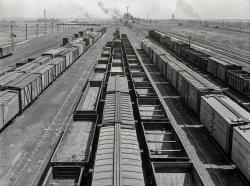
- Submariner: 1908
- ... close to half a century. I rode in them many times between Jersey City and Manhattan during the 1940s and 50s. By then, as you would ... Posted by Dave - 08/04/2012 - 9:46am -
![Submariner: 1908 Under the Hudson River circa 1908. "Interior of car, N.Y.-N.J. Tunnel." Today this would be the PATH train. 8x10 glass negative, G.G. Bain. View full size.
InterestingA little surprised to see a "smoking prohibited" sign back in a time when smoking really wasn't an issue. Maybe it's for safety reasons.
Not too crowdedIs that Stan Laurel in his younger days reading the paper?
Great detailWhat do you think is the purpose of the finger pulls along the top on both sides?
[Maybe ventilation. Some of them are open, like the one on the left below. - Dave]
Sweet!No graffiti or advertisment in sight, sweet it was!
NiceThat's a really nice looking car and I bet it doesn't smell like urine. Since it's 1908, I'm guessing this was taken when the car was stationary or we'd see blurring.
[Or maybe not. This photo was taken with a flash. - Dave]
Beautiful!The dividers between the seats add so much visual interest -- wish we still had them. The light bulbs are fantastic! Wonder when the first overhead fans were installed? In the dog days of summer, these early cars must have felt like rolling kilns.
Two Styles of BulbNote the single-hairpin-loop Edison/Mazda bulbs as well as the smaller and slightly earlier style Edison bulb
that can be seen nearer the center of the car.
http://electriclights.tripod.com/bulbsantique1.htm
I have four working Mazdas from 1907; I use them, two each, in my bath & kitchen. They shine a pleasant shade of amber
without any globe over the bulb that never blinds one's eyes.
The Hudson TubesThis car was operated by the Hudson and Manhattan Railroad in what were commonly called the Hudson Tubes. The line was taken over by the Port Authority Trans-Hudson Corporation (PATH) on September 1, 1962. The takeover was closely intertwined with the construction of the World Trade Center.
See http://www.hudsoncity.net/tubesenglish/3-operatinghistory.html
The "black cars" like the one in the photo remained in service for close to half a century. I rode in them many times between Jersey City and Manhattan during the 1940s and 50s. By then, as you would expect, the cars were old and dingy. The only touch of modernization was the installation of newer light bulbs. The seats were very hard and uncomfortable, the cars noisy and hot in the summer since they obviously were not air conditioned. The introduction of the "K" cars in the late 1950s and early 60s was a huge improvement.
See http://www.hudsoncity.net/tubesenglish/6-fleet.html
If OnlyAhh, if only this were the train I took from Newark to school in NYC.
Nature's breezesAs there are interior bars and exterior grills on the windows, I suspect that these might've been raised during warmer times of the year, giving passengers some semblence of relief, in the era before widespread use of deodorant.
Until the mid-1950s, NY's BMT line ran very old open vestibule cars whose windows were fully opened in the summer months. 1/2 inch horizontal bars kept passengers from leaning out the open windows.
The car in the photo appears to have been configured to hold advertising signs. Just like later generation subway cars, the signs would be held in place on the curved portion of the top of the side walls just above the windows. So maybe they were removed for the photo shoot?
[This was a brand-new car. The picture was taken in 1908, the year the tunnel under the river was finished.- Dave]
High class passengers onlyI wonder how many seconds those light bulbs would last on today's subway.
Where's Ollie?Interesting to see Stan Laurel reading a paper on the train, huh?
Clerestory ventsThe fittings shown enable car workers (using a window pole) to open and close the hinged vent windows on the clerestory running along the roofline of the car. A very common feature on all passenger cars (subway, elevated and regular rail) until about the 1930s.
Horrors of Days Gone ByThis photo brought back memories of being a little girl of about 7 and riding the train to Coney Island. Those seats you see were made of woven bamboo or something. Sitting on them for hours (while wearing a sundress) in the blazing summer heat was not only sweaty and prickly, but one disembarked with a basketweave behind. Funny the things that stay in your mind from childhood.
Hard-wearing seatsThose seats were made from "transit weave" rattan. They weren't made with sundresses in mind, but rather grubby workmen in dirty clothes. Almost impossible to stain (provided they kept applying the linseed oil or varnish) and very durable.
Chicago had cars with this material as late as the early 1960s.
Flashed on the TrainFlash back then wasn't anything like what we now know as flash. It might have even been flash powder(magnesium) in a tray. Light output was not the instant blip we're so familiar with today.
ScrewedRegarding the statement "High Class Passengers", chances are the bulbs would still be in their sockets and not in someones home because the bulbs made for the transit system screwed in the opposite direction of standard bulbs so that you were not able to use them out of the transit system.
The smell of the subwayThe earliest subway cars I can remember had air plane like seating, two on the left, and two on the right, all the seats were rattan, (bamboo splints), and I just wanted to be tall enough to reach one of the many 'commuter straps', actual leather straps that hung from the ceiling, far above the chrome pole that I clung to with my grandma!
(The Gallery, G.G. Bain, NYC, Railroads)](https://www.shorpy.com/files/images/01350u1.thumbnail.jpg)
- Generation Gap: 1955
- ... also born in Italy (1904) came to US in 1908. Settled in Jersey City (I think the Jersey water is why her hair never turned gray). ... Posted by tterrace - 09/20/2011 - 11:00pm -
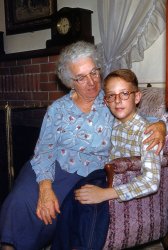
- Pier Thirteen: 1905
- ... directly across the Hudson in the Paulus Hook section of Jersey City on the waterfront, and occupied several blocks.
A Few More Odd ... Posted by Dave - 07/31/2012 - 2:58pm -
![Pier Thirteen: 1905 New York circa 1905. "Piers at foot of Wall Street. Steamship Curityba and sidewheeler Nantasket." Not to mention that fine-looking Colgate wagon. 8x10 inch dry plate glass negative, Detroit Publishing Company. View full size.
Anchors AweighSurprised to see the Curityba has dropped her anchor while tied up at the dock. Never heard of that being done - maybe they're just washing it?
Sign Painter's NightmareGod bless whoever had to do the signage on the Pier 13 building. The corrugated ribs on the tin siding must have driven him crazy!
Steamship Curityba HistoryInteresting history of the Steamship Curityba. A search of the name reveals she was very active, and there are several stories in the New York newspapers about her. Around 1914 she was sold to a consortium led by an African Chief, Alfred Charles Sam of the Akim Tribe, renamed "Liberia" and was to be used to "repatriate" 4-500 African Americans to Africa. Ultimately only about 60 made the trip, it failed miserably, and most returned to America. It appears the ship was abandoned in Africa because of its deteriorated condition. Here are a couple of links with more info.
Link 1
Link 2
Pier location anyone?Does anyone know where Pier 13 was? Maybe near present day South Street Seaport, which is Pier 17?
Pier LocationThe caption says "Piers at foot of Wall Street." That current location at Wall and South Streets is a large pier serving several ferry lines, including the East River Ferry and the very popular Ikea Ferry to the store in Red Hook, Brooklyn.
ColgateThe wagon says 'Colgate'. Could that be what is now Colgate Palmolive?
[Could be. - tterrace]
Colgate WagonYes, the Colgate wagon is from the precursor to today's Colgate Palmolive. The Colgate factories were located directly across the Hudson in the Paulus Hook section of Jersey City on the waterfront, and occupied several blocks.
A Few More Odd Features of CuritybaThere is a forestaysail furled, visible just abaft the anchor davit. Steadying sails on steamers were definitely passe' by 1905.
Also, there's what looks like an anchor light, of the kind that was available until recently, hoisted partway up the fore topmast stay, in the same position used by yours truly on his own boats because that position provided a good arc of view. The anchor lights I used were battery powered but it looks like the one on Curityba is electric, with a wire running up the stay with attachments every few feet, very similar to hanks used to attach a sail to the stay. The downhaul attached to the light with a bridle is meant to hold it as close to vertical as possible, because the small Fresnel lenses used on those lights concentrated the light in a horizontal plane when the light was vertical. This anchor light deployed for use might be related to the port anchor being lowered partway; either the ship has just docked after spending considerable time at anchor, or the captain expects to have to anchor overnight rather than steaming away at once when he leaves the dock. Anchor lights are required only during the hours of darkness, at least by present day rules.
Maritime commerce in that time period ran at a more stately pace than it does today.
Alfred Charles SamThanks for those links Mr. Dog. A truly fascinating episode in our history. Most surprising was to learn that many of the freed slaves involved had been the chattel of American Indians of the "Five Civilized Tribes".
In fact, as recently as last year the question of whether these Freedmen were citizens of the Cherokee Nation was being adjudicated. "Cherokee District Court Judge John Cripps ruled in favor of the plaintiffs in the Raymond Nash et al v. Cherokee Nation Registrar case, reinstating Cherokee Nation citizenship and enrollment to the Freedmen descendants."
The descendants of freed slaves may actually be Cherokees, though few seem to know or care. Their forefathers were the ones Chief Sam promised to return to their ancestral home in Africa.
Munson steamer CuritybaLaunched August 1887 at the Reiherstieg shipyard in Hamburg, Germany, for the Hamburg-Southamerican Steamship Company ("Hamburg-Süd"); sold 1890s to the Munson Line. Renamed LIBERIA in 1914 and MARYANNE in 1917. Breakup at Vigo, Spain, in 1921.
Not to be confused with another ship of the same name, originally the HOLSTEIN, sunk off Norway in 1942 by a Russian sub.
re: Pier location anyone?Should be approximately 4 blocks south. the pier numbers are generally equal to streets but things get a little weird in the financial district because it predates the street grid.
(The Gallery, Boats & Bridges, DPC, Horses, NYC)](https://www.shorpy.com/files/images/SHORPY_4a17701a.thumbnail.jpg)
- Cortlandt Street: 1908
- ... from Plainfield NJ to the train at Scotch Plains NJ, to Jersey City, across the river by ferry, a walk up Cortlandt Street to the ... Posted by Dave - 08/01/2012 - 5:46pm -
![Cortlandt Street: 1908 New York circa 1908. "Cortlandt Street." Lapping at the balmy shores of the Glen Island Hotel, with the new Singer Building rising in the distance. 8x10 inch dry plate glass negative, Detroit Publishing Company. View full size.
Ground ZeroThe hotel sat at 115 West St & Cortlandt. It's now the site of the new World Trade towers and the 9/11 memorial.
Cortlandt, back in 1960At that time, Cortlandt Street was teeming with small shops, mostly associated with radio parts and consumer electronics suppliers. It was one of the travel links I used to travel up to 42nd Street in midtown, one leg in a trip that began with a drive from Plainfield NJ to the train at Scotch Plains NJ, to Jersey City, across the river by ferry, a walk up Cortlandt Street to the subway, and finally, to midtown. A most interesting and varied commuting route.
WTC etc.Whoa, this is basically on West Street facing east, right at the base of where the World Trade Center was.
Also, looked up Oelsner's Pilsner. Haven't found much, yet.
Radio Row!So this is what "Radio Row" was like before Marconi came along & everything went downhill.
Historical LocationCortlandt Street has played many roles in 20th and 21st century history. It was home to "Radio Row," a substantial congregation of radio and electronics merchants from 1930 to 1970. Replaced by the now infamous Twin Towers of the World Trade Center.
6th Avenue Elevated[This shows the Ninth Avenue Elevated line, not the Sixth. - Dave]
This is looking east toward the 6th Avenue Elevated line (it is running on Greenwich Street at this point), which ran to South Ferry and where one could connect with ferries to Governors Island, Staten Island and other points. Connections could be made to 3rd Avenue and 2nd Avenue Elevated Lines at that same destination.
The conduit streetcar of the Metropolitan Railway is short-switching instead of going down to North River. It will run crosstown to East River and a point under the Brooklyn Bridge. Conduit cars replaced cable cars and drew power from rail in slot between two running rails, as shown in the photo.
Cortlandt Street, in addition to being "Radio Row," was a center for WW2 surplus and street cart merchants.
Dave's note at head of this entry is correct. My memory was faulty on this point.
The 6th and 9th Avenue Elevateds shared common track both uptown and downtown, but diverged north of Battery Place and coincided again uptown. The station on Greenwich and Cortlandt in photo is 9th Avenue line. 6th Avenue Elevated Line Station was east at Cortland and Trinity Place.
See map at :http://www.nycsubway.org/perl/caption.pl?/img/maps/irt_1906_railways_guide_54.gif
The New Cortlandt StreetThe shopping district, known as Radio Row centered on Cortlandt Street from 1921 through its demise in 1966 when the most of the area was condemned to make room for the World Trade Center. The exact count of stores is unknown, an educated guess put it at 70 over those few blocks anchored by Cortlandt. I never worked there, in 1966 we were basically in the Kitchen Appliance and Radio/ TV business in Queens and the Nassau/Suffolk County areas. We came to Manhattan around 1974, Radio Row was gone, a mini replacement was happening on West 45th Street between 5th and Sixth Avenues. When we first got there, there were 11 storefronts there that sold Electronics, ours was the 12th. A few Cortlandt Street holdovers were in the neighborhood as well, Leonard Radio, Davega, Lafayette Radio among others. Over the next 30 years probably 25 more stores came and went. We sold our shop in 1998, My Brother retired and I stayed with the new owners for a few years . At the end only our store, Sound City and the esoteric Harvey Electronics remained and they are both now gone as well.
In motionnearly 21 years later. A Fox Movietone camera recorded street scenes on Ccrtlandt for posterity.
https://www.youtube.com/watch?v=h4ArWEgINIg
(The Gallery, DPC, NYC, Streetcars)](https://www.shorpy.com/files/images/4a22878a.thumbnail.jpg)
- The New World: 1936
- ... into Manhattan; instead, they used the CNJ terminal in Jersey City, from whence a fleet of "motor coaches" (never, ever "buses" in ... Posted by Dave - 01/10/2016 - 1:04pm -
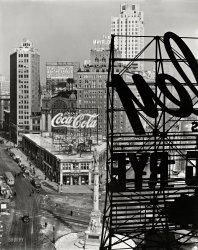
- Too Much Fun: 1905
- ... and so incorporated The Miniature Railway Company, of Jersey City.
For years the two businesses were nearly indistinguishable ... Posted by Dave - 08/05/2012 - 1:49pm -
![Too Much Fun: 1905 New York circa 1905. "Dreamland Park at Coney Island." Among the amusements to be sampled: An observation tower, the Bostock trained animal show, a Baltimore Fire cyclorama, the General Bumps ride, a miniature railway, Will Conklin's Illusions, the Temple of Mirth and Hooligan's Dream. 8x10 inch dry plate glass negative, Detroit Publishing Company. View full size.
Oil burnersThese were oil burning steam locomotives.
The Miniature Railroad was built by the Cagney Brothers in 1904 to replace an earlier version that was lost in a November, 1903 fire. It made a circuit of the park running underneath the promenade. The locomotives, which could pull three of the two-passenger cars, were built by the Cagney Brothers' Miniature Railway Company in New York. Their ad below is from the February 7, 1903 issue of The Billboard.
An earlier Shorpy post with a closeup of one of the locomotives has more information here, and a 1903 Edison silent movie of Coney Island before the fire (found here) shows the train emerging out from under the promenade at the 7:44 minute mark.
You Can't Miss MeI'll be the one wearing a mustache a hat and a dark suit. The cops must have had an awful time with witness descriptions of the perps back then.
Where to look first?There are so many wonderful aspects to this picture, I hardly know what to take in first. I love the "Temple of Mirth" (Can you imagine "mirth" being used on a ride today? How many folks even know what it means anymore?) I also love the "Hooligan's Dream" (but ditto on the meaning being mostly lost on 21st century folk). What REALLY intrigues me however, is what the people in the forefront are looking at instead of the elephants right behind them, which I would be fascinated by. Surely elephants weren't a commonplace sight.
[Happy Hooligan, whose image is in the circle on the sign, was an extremely popular comic strip character of the time. - tterrace]
Soon to be gone - againDreamland was rebuilt in early 1904 after a disastrous fire destroyed it in November, 1903. Six years after this picture was taken this scene was again destroyed by fire. It made news even in far away Australia where, two days later, the tragedy was reported by The Argus newspaper.
FIRE AT CONEY ISLAND.
AMUSEMENT PALACE DESTROYED.
DAMAGE 3,000,000 DOLLARS.
NEW YORK, May 27.
A destructive fire occurred yesterday at Dreamland, one of the great amusement resorts at Coney Island, New York. The damage is estimated at 3,000,000 dol. The menagerie was destroyed, 50 wild animals being cremated. The adjoining place of entertainment, Luna park, was saved.
[Dreamland and Luna Park practically constitute Coney Island, which is the greatest resort of its kind in the world. The resources of inventors are taxed to provide new thrills, with the result that each season finds some ingenious novelty installed for the New York clerk and shop-girl. Dreamland contains dozens of forms of entertainment. The visitor may travel by captive airship, or glide at fearful speed down the chute, through a cascade of real water. He may "loop the loop" in a car, or travel in a small chariot over an undulating sea of metal, the waves of which are caused by machinery below. The "Rocky Road to Dublin, " a fearful switchback apparatus, and "General Bumps," involving a hazardous slide down a polished wooden surface, are among the joys of the place; while those who desire to visit other lands may take a trip to the North Pole or the wilds of Central Africa with equal ease and cheapness.]
A more complete newspaper story with pictures of the aftermath can be found here, and a few more pictures can be seen here and here.
The steam locomotivehas been hooked up to some pretty fancy oversized cars, and can you believe observing HYENAS for 25 cents, forget lions and panthers, they've got HYENAS !
Bostock's Wild Animal Exhibition
Broadway Magazine, April 1905.
Although Coney Island has improved greatly in the character of its shows within the last few years, the same atmosphere of careless holiday-making prevails, and you always have a feeling of jolly irresponsibility as you go from one place of amusement to another.
Bostock's wild animal exhibition in “Dreamland,” is again a prominent feature of the summer. The animals are interesting, whether in their dens or in the arena, while the trainers who put the savage creatures through performances in the large steel cage are as impressive as ever.
There was one act I saw at Bostock's lately which struck me as particularly good. A young lady in short skirts, who was announced as “La Belle Selika,” skipped into the cage with seven—I think it was seven—lionesses. She made them get up, reluctantly, upon pedestals in different parts of the cage. Then, as the orchestra struck up the music of the “Pretty Maidens,” in “Florodora,” she danced, teasing the animals by pointing her slippers at them one after another, and retreating just far enough to escape the angry paws darted at her each time. They seemed eager to tear her to pieces. She pirouetted about the creatures, always close to them, but just far enough away to avoid being clawed, until at last she struck an attitude immediately in front of the most savage of her pets and smiled in response to the applause, while the lioness growled. It was decidedly the prettiest act I ever saw in connection with trained wild animals, and it looked fearfully dangerous, whether it was so actually or not
Live Steam?I would assume that that little locomotive was actually a steam powered kerosene burner... does anyone know?
UPDATE: The kerosene assumption was (wrongly) made because I couldn't imagine firing a firebox that small with coal to maintain a working head of steam - Ausonius.
Pigmy Locomotive While the Cagney Bros. operated many miniature railway concessions, the actual builder of this engine was the McGarigle Machine Co, of Niagara Falls, NY. Tobbacconist, is there something in the photo that indicates oil as the fuel source? The following article states the originals were built with a 10 inch firebox burning anthracite. I think this engine is coal fired. In 1905, coal was still a widely available and familiar fuel. Also, the trousers on the engineer appear rather well coated in coal dust. [Additional information and photos.]
The Railway Age, July 1, 1898.
A Pigmy Locomotive.
What is claimed to be the smallest locomotive ever made for drawing passenger cars has been made for the Miniature Railroad company by Thomas E. McGarigle of Niagara Falls. This steam railroad is to be operated at the Trans-Mississippi Exposition in Omaha, Neb., and, in all, six locomotives are to be built for the company under the present contract. It is possible they will be used at other resorts, such as Coney Island, Atlantic City, Deal Beach, Washington Heights and Niagara Falls. …
The height of the locomotive from the top of the stack to the rail is 25 inches, and the gauge is 12½ inches. The cylinders are 2x4 inches. The boiler is 1½ horse power, made of steel, and is tested to 300 pounds pressure, and will hold 24 gallons of water. …
The firebox is 10 by 10 inches. The weight of this little engine is about 600 pounds, and it will run on a rail three-quarters of an inch square. Hard coal will be used as fuel. The capacity of the locomotive is 10 cars, each containing two persons, or about 4,000 pounds. The locomotive is equipped with sandbox, bell, etc., and has a steam brake between the drivers. One man, whose position will be on a seat in the tender, operates the engine. The scale on which the locomotive was built is about one-seventh that of one of the New York Central's largest engines, and as it stands in the shop it has a very businesslike appearance, as shown by the illustration.
Live Steam Model FuelsThere`s no guarantee or requirement that this locomotive is oil fueled. Even today Live Steam enthusiasts operating large scale locomotives are running with a variety of fuels. Propane is popular as is oil or kerosene. However coal is still the most popular fuel for ridable trains like this and can be used at gauges as small as 1.26 inches. So unless there were other considerations, like local laws, there`s a high likelihood that this engine was coal fired.
All in the FamilyYes, a great number of the 'Cagneys' (as they were known) were built in the Niagara shop of Thomas and Peter McGarigle; however, since their sister Winifred married Timothy Cagney, it was considered to be all in the family. Peter—an engineer—was mostly likely the one who designed the first of the miniature locomotives, ostensibly in 1885. In the early 1890s Timothy and his brothers David and John, were running a ticket brokerage company known as Cagney Bros. in New York, but by 1898 decided to fully concentrate on marketing the McGarigle locomotives and so incorporated The Miniature Railway Company, of Jersey City.
For years the two businesses were nearly indistinguishable from one another, and were in fact interchangeable as far as miniature railways were concerned, as they worked together on various projects. In 1903 the Cagney Bros. Co. was ensconced in the Planter's Hotel in St. Louis—there to build the eight mile miniature railroad that would run through the grounds of the St. Louis Purchase Exposition (the 1904 World's Fair). Timothy Cagney was listed as President, and Peter McGarigle as Chief Engineer. While the Cagney Brothers' Miniature Railway Company was selling the vast majority of the McGarigle railroad oriented output, the Niagara firm was still peddling their own product as late as 1915 when they made a proposition to the City of San Francisco to operate a miniature railway in the park.
By the 1920s however, the Cagney Bros. had absorbed the miniature railway portion of the McGarigle Machine Company, and McGarigle's—once also known for their gasoline marine engines—appears to have been reduced to being an automotive machine shop. The locomotive building operation was now referred to as "the Cagney Brothers' Amusement Company Niagara Falls plant." By the 1940s the late Timothy Cagney—and not Peter McGarigle—was being given credit as the inventor.
According to one report, two of Cagney's "best known installations were two gold-plated trains with steam locomotives built for the King of Siam, and the 'Trip Around the World' exhibit at the New York World's Fair of 1939 and 1940."
As for the oil burner reference, it's from a list of Coney Island rides and shows complied by Kingsborough Community College Professor Emeritus (and former Brooklyn Borough Historian, director and archivist) John Manbeck. He complied a vast collection of Coney Island ephemera that has since been donated to the Brooklyn College Library. On his list of rides and shows is this entry:
A Miniature Railroad built by the Cagney Brothers made a circuit of park beneath the promenade. Each of its three small cars, pulled by a small oil-burning steam locomotive, held two passengers.
I do not know what his original source was (but I'll try to find out); however, while the vast majority of the McGarigle/Cagney locomotives were coal-fired, it makes sense that these would be oil-fired as it would have virtually eliminated the fear of sparks from the smoke stack—especially so soon after the disastrous 1903 fire.
(The Gallery, Coney Island, DPC, Railroads)](https://www.shorpy.com/files/images/SHORPY_4a17574a.thumbnail.jpg)
- Train Wreck: 1909
- ... Pennsylvania R.R. car on tracks south of Brunswick Street. Jersey City, N.J. November 6, 1909. View full size. George Grantham Bain ... Posted by Dave - 09/07/2011 - 6:11pm -
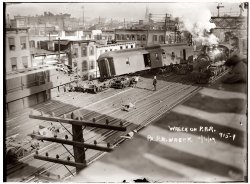
- Now Highering: 1912
- ... as "The Tubes"; service began between Lower Manhattan and Jersey City, July 19, 1909. Known today as the PATH System by the younger folk, ... Posted by Dave - 10/16/2019 - 8:44pm -
![Now Highering: 1912 New York circa 1912. "Broadway, looking north from Cortlandt Street and Maiden Lane." Our second look in recent weeks at the Woolworth Building in the final stages of construction. 8x10 inch dry plate glass negative. View full size.
Mourning jewelry window signAs anyone who every watched "Antiques Roadshow" or has done any research into old jewelry knows, it used to be a common practice to mourn one's dear departed with "remembrance" jewelry to keep in mind the loved ones who are no longer with us. Some people were in mourning for years and others, like Queen Victoria, mourned her late husband Albert for the remainder of her long life. Lots of this jewelry has black stones or black metal and some of it even incorporated locks of hair of the deceased. Some of it was exquisite and very expensive and is in museums it is so valuable, and some not so much. I had never seen it advertised in other Shorpy pictures though, so this is a first for me.
"The Tubes"Pole sign, "Hudson Tunnels" - The Hudson and Manhattan Railway Tunnels - Known locally as "The Tubes"; service began between Lower Manhattan and Jersey City, July 19, 1909. Known today as the PATH System by the younger folk, but still the Tubes to me.
What, pray tell... is that statute on top of one of the buildings.
[Appropriately enough, it's atop the Walkover Building. -tterrace]
Cable railwayMany people will know of the cable cars of San Francisco, this picture shows a similar system in New York. The Broadway cable railway opened in 1893 and ran Battery Place from Whitehall Street to Broadway - Broadway to Seventh Avenue - Seventh Avenue to 59th Street.
The motive power was provided by a continuous steel cable running in a slot under the street between the rails. The central powerhouse was at Houston and Broadway.
[Those slots are for access to underground electrical conduits. The last of Manhattan's cable-powered lines had been converted to electricity by 1901. -tterrace]
street lightWhat is the smaller light (?) just behind the street light across Maiden Lane?
Conduit CleaningThe rectangular panels located between the streetcars' running rails and the centered slot rails were to allow access to the electrical conduit whenever necessary to clear the conduits accumulation of the abundant brown debris seen on the surface of the street.
PurportedlyWoolworth could see the completed building from his summer home, Winfield Hall, in Glen Cove on the North Shore of Long Island.
Just for comparison, The Woolworth Building started construction in 1910, and Winfield Hall was rebuilt (after a rather suspect fire) in 1916; the skyscraper cost an estimated $13.5M to build, while the rebuilt Winfield Hall racked up an impressive price-tag in excess of $11M -- including a $2M marble staircase.
Fire Alarm Box LightIn response to the post by Jmarksr: The smaller light beyond the streetlight marks the location of a Fire Alarm Box. This lamp will have a red glass shade. At night, one could immediately locate the nearest fire alarm box by looking for a red lamp.
In my youth, the globes in some towns & cities were red, and in others the globes were orange. I don't know why.
(Some towns also had green lamps on police call boxes.)
The early fire alarm boxes were "Telegraph" boxes which used an ultra-reliable spring-wound clockwork mechanism to tap out the code of the fire box on a dedicated telegraph line to the Fire Dept., where it was recorded as punch marks on a moving paper tape. (Later, some cities converted to an actual telephone system.)
The telegraph system was powered from lead-acid batteries at the Fire Dept. It would function even during a power failure, as the batteries could support the system for many days.
(The Gallery, DPC, NYC, Streetcars)](https://www.shorpy.com/files/images/SHORPY-4a25583a.thumbnail.jpg)
- Hoboken Public Bath: 1905
- ... a prosperous Hudson merchant and banker. She was built at Jersey City for the Romer & Tremper Steamboat Company to run day passengers ... Posted by Dave - 02/13/2017 - 10:44am -
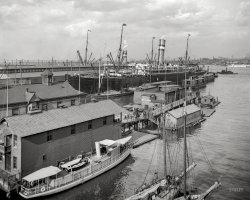
- Five O'Clock Sailors: 1960
- ... the Hudson River into Manhattan. Soon after departing the Jersey City terminal I snapped this photo of the Ferry Wilkes-Barre with its ... Posted by prrvet - 09/24/2019 - 11:44am -
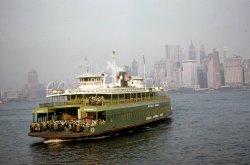
- Four Generations
- ... Four generations of Kucks/Meyer. This was taken either in Jersey City or Hoboken, New Jersey. View full size ... Posted by perkyjohn - 12/20/2011 - 2:29pm -
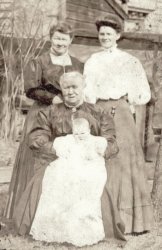
- Captain Kinescope: 1929
- ... wires from the studio of the Jenkins Television Corp. at Jersey City, N.J."
1928. Washington, D.C. "Inventor Charles ... Posted by Dave - 05/02/2019 - 9:04pm -
![Captain Kinescope: 1929 UPDATE: "Pioneer television inventor (Dr. C. Francis Jenkins, not pictured) opens new radio movie broadcasting station. Laboratory assistant Paul Thomsen examining machine made to broadcast motion pictures by radio." More photos here.
Washington, D.C. July or August 1929. "NO CAPTION" is all it says on this Harris & Ewing glass negative with an audiovisual vibe. Who can help us fill in the blanks? View full size.
TV film scannerIt appears to be an experimental television film scanning device making use of a Nipkow disk.
Related to C. Francis Jenkins?Given the place and year, it may be a demonstration of the mechanical television system built by C. Francis Jenkins. Jenkins's lab was in Washington. His television broadcasting station, considered by many to be the first in the U.S., was in Wheaton, MD. The man in the photo is not Jenkins.
(Very) Early TelevisionStarring Washington, D.C., inventor Charles Francis Jenkins (1867-1934), a pioneer in electro-mechanical video (whose memoir, "The Boyhood of an Inventor," can be downloaded here). Click to embiggen.
1922. "Washington, D.C., inventor C. Francis Jenkins."
1923. "Inventor C. Francis Jenkins with most recent invention, radio camera with which it will be possible to send pictures by wireless. He hopes to be able to broadcast moving pictures of national events to distant cities immediately after they are photographed."
1923. "C. Francis Jenkins with apparatus machine for pictures by radio."
1925. "Motion pictures by radio are very near, predicts C. Francis Jenkins, who has designed this small radio-vision receiving set for use in the homes. It is only a few inches square and is attached to the regular radio receiving set. A miniature motion picture screen is placed on the wall of your home, as shown in this photo. The first of this machine to be made. The photo was taken in Mr. Jenkins' laboratory at Washington, D.C."
Circa 1927. "D.E. Replogle giving the first public demonstration of talking moving pictures being transmitted over radio without the use of land wires from the studio of the Jenkins Television Corp. at Jersey City, N.J."
1928. Washington, D.C. "Inventor Charles Francis Jenkins inspecting the first new television receiver made for home use."
1928. Washington, D.C. "Charles Francis Jenkins (2nd from left) showing his Mirror Drum Television Receiver."
June 23, 1928. "C. Francis Jenkins, noted Washington inventor, inspecting the apparatus which he will use to broadcast motion pictures by radio beginning July 2, 1928."
July 1929. Washington, D.C. "Dr. C. Francis Jenkins with Stuart Jenks, an associate engineer, examining a machine made to broadcast motion pictures by radio."
July 19, 1929. Washington, D.C. "Pioneer television inventor opens new radio movie broadcasting station. Dr. Charles Francis Jenkins with the main transmitting panel of the radio movie broadcasting station."
Oct. 15, 1929. Washington, D.C. "And now the radio movies go talkie. Dr. Charles Francis Jenkins with his latest achievement, a receiving instrument which will simultaneously respond to both words and images."
Nov. 6, 1929. "Dr. C. Francis Jenkins, noted inventor and television pioneer, directing a scene in his new studio in Washington, D.C., the first devoted exclusively to the production of motion pictures to be shown to an audience by radio; note that the performers are shown in silhouette, that being the form in which the pictures are received over the air, and that the cameraman is a girl."
July 9, 1931. "The chief signal officer studies television. General Irving J. Carr, of the United States Army, examining a television receiver at his office in Washington."
Oct. 26, 1931. "Misses Fay Christian and Kay Campion with a television, which was being shown at the Seventh Annual Industrial Exposition, Washington, D.C."
Phenomenal Photos!These photographs are PHENOMENAL. More than once I whispered, "Wow," to myself as I scrolled through them.
Thank you for sharing them!
As someone who teaches TV and film, I am legally required to pedantically point out that this machine is the opposite of a kinescope. A kinescope is, essentially, a film camera that records TV images. Jenkins's device is a TV camera that transmits film images.
So, Captain Kinescope is actually ... um... Mister Mechanical (TV)? Sorry. The alliteration is just not there.
[The term "kinescope" was coined by the inventor Vladimir Zworykin in 1929 to refer to the cathode ray tube in a television receiver. It was only much later that the word was applied to film recordings of TV. - Dave]
TelecineI think this is more-or-less the opposite of what we could call a kinescope - it's a Telecine setup, enabling a movie to be broadcast on "radio". In this case, using a mechanically-scanned TV system. Such things existed (with electronically-scanned TV) well into the 21st century.
(Technology, The Gallery, D.C., Harris + Ewing, Movies, TV)](https://www.shorpy.com/files/images/SHORPY-35461a.thumbnail.jpg)
- The Blizzard: 1899
- ... _might_ be the Hudson & Manhattan RR powerhouse in Jersey City, seen from an angle such that only three of the four stacks are ... Posted by Dave - 01/26/2015 - 12:21pm -
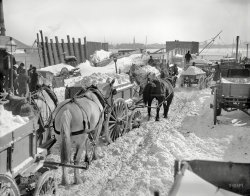
- Beatles . . . Eat Your Heart Out
- ... This is my older brother and sister, taken at home in Jersey City, NJ, in February 1965 before I was born. The Beatles had arrived in ... Posted by Photoscream - 09/10/2010 - 7:20am -
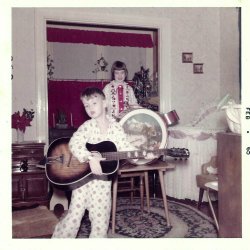
- Off to School: 1964
- ... probably taken in early 1964, on Pamrapo Avenue in Jersey City, NJ. This was a neighborhood on the brink of change. A public ... Posted by Photoscream - 09/10/2010 - 7:23am -
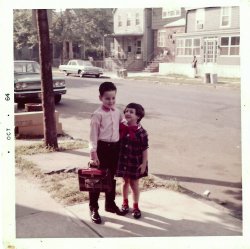
- Grandfather Al Meyer & Friends
- My grandfather (AL Meyer) either in Jersey City or Hoboken. I know nothing else about the photo. View full size. ... Posted by perkyjohn - 03/12/2010 - 4:04pm -
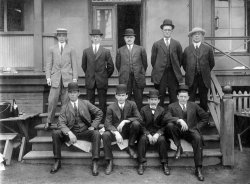
- Next Stop, Exchange Place
- ... grandfather Joseph Kaiser in front of his Exchange Place (Jersey City NJ) bus around 1920. View full size.
(ShorpyBlog, Member ... Posted by Photoscream - 07/08/2010 - 1:53pm -
